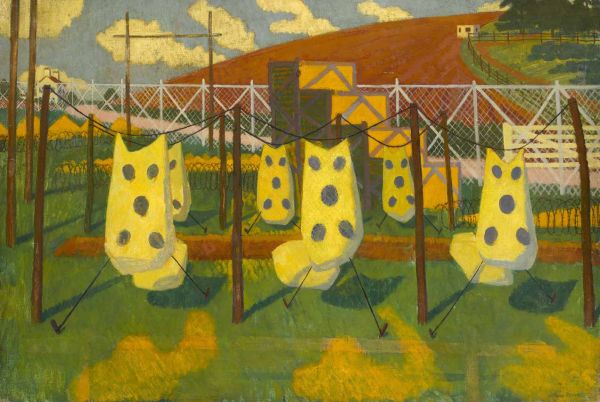
War Landscape, Britain 1942
Framed (ref: 3600)
Signed
Oil on canvas
24 x 36 in. (61 x 91.4 cm.)
Tags: John Powell oil landscape war World War II Paintings by British Artists

Signed
Oil on canvas
24 x 36 in. (61 x 91.4 cm.)
Tags: John Powell oil landscape war World War II Paintings by British Artists
"Dear Mr. James,
In response to your telephone call I am putting
together a few facts and some thoughts about the painting 'Corps de
Sacks'. Recalling exactly when John Stocks called on me and took the
piece has eluded me. It must have been around the middle of the
eighties. David Cohen's acquisition of the work is documented. Enclosed
is a copy of my reply to his enquiring letter and identifying colour
transparency. Note that, while my letter confirms 1942 as the date for
the subtitle, the making of the painting spanned from 1942 to 1945. The
reluctance of painters to make statements about their work, I share.
Such explanations tend to limit the possible range of meanings of a
work. Therefore, I approach writing about 'Corps de Sacks' with
temerity. Pure abstract, painterly interest in juxtaposing shapes,
patterns and colour was the initial 'conscious' motivation of the work,
leading to a composition similar in structure to that of a musical
composition. In contrast, in this instance, the content came probably
from the subconscious, but it is inseperable from purely aesthetic
matters. While a student, I painted a hospital figure composition. It
drew from my professor the comment that the painted image of a sick
person should not make the observer feel sick. The 'message' of 'Corps
de Sacks', by implication, presents the grim reality of war, without the
explicit violence which is currently fashionable in all the media.
Anguish may be felt following from the free ranging imagination of the
observer. In a wider sense the piece is a metaphor for man's inhumanity
to man. The word man often equates with evil and wickedness. Men's words
are frequently piously utopian, but secretly men seek advantage over
their fellows. The 'Corps', therefore, has emblematic content. The
'sacks' with their 'domino like' markings indicating army training, a
chance screening, at reserve camp, set me aside to be a technical
instructor in radar ,while most of my comrades went to Cyprus and were
lost. While being privileged to use my intelligence towards the war
effort, I never lost awareness that all was concerned with killing.
Perhaps
I should add a few comments about the tinted drawing 'The Artist's
Billet', which was exhibited at King Street Galleries, London, in
November 1992. In the exhibition catalogue the drawing as stated to be
in charcoal and water colour, but pencil was used, not charcoal. The
setting a room in requisitioned premises in Islington, ondon. The
drawing was made it 1943, but the incident which provided its subject
occurred almost two years earlier. Civilian billets, despite their total
lack of furniture, with beds of mattress 'biscuits' on the floor, were
preferable to Nissen hut barrack rooms. Many privations were preferred
to endurance of the communal odour from too many men in a confined
space. At the time of the incident $ had been posted to attend
Northampton Polytechnic, London, for the lengthy (3 months) first part
of my radar course. The model for the very tall figure featured in the
drawing was also a student on the course.
I hope that the
foregoing information and comments will satisfy your requirements,
though selection and editing may be necessary to produce your exact
needs. Should you be visiting West Sussex and have time and inclination
to call and see work in my studio, please phone in advance and I will
give you route directions.
Yours sincerely,
John Powell"